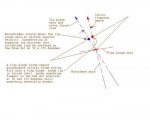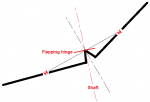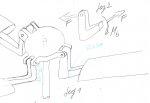I don't doubt that the disk plane is usually not perpendicular to the shaft in fully articulated rotors, but I insist in that the axis of rotation (of the real rotation, not the shaft axis) is almost always perpendicular to the tip-path plane. There may be moments when it isn't, as when the blades, following a cyclic input, are in the process of finding a new plane of rotation, or when other de-stabilizing inputs throw the rotor system out of equilibrium, but 'in business as usual', the blade tips of a fully articulated rotor describe perfect, flat circles with a perfectly uniform rotation. As seen from that real-rotation axis (or as seen by a distant observer) the blades describe smooth circles, without flapping and without lead-lagging movements. Of course, the flapping- and lead/lag hinges are incessantly working all the time. That action of the hinges is, precisely, what makes the smooth circular motion of the blades possible...




